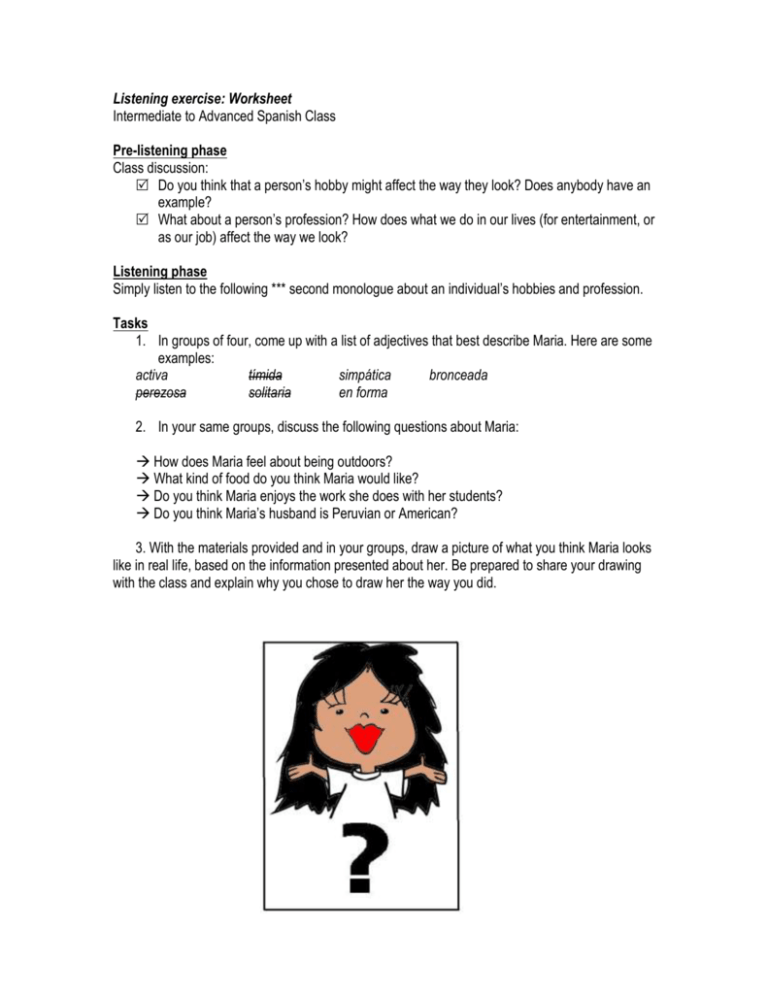Listening exercise
advertisement

Listening exercise: Worksheet Intermediate to Advanced Spanish Class Pre-listening phase Class discussion: Do you think that a person’s hobby might affect the way they look? Does anybody have an example? What about a person’s profession? How does what we do in our lives (for entertainment, or as our job) affect the way we look? Listening phase Simply listen to the following *** second monologue about an individual’s hobbies and profession. Tasks 1. In groups of four, come up with a list of adjectives that best describe Maria. Here are some examples: activa tímida simpática bronceada perezosa solitaria en forma 2. In your same groups, discuss the following questions about Maria: How does Maria feel about being outdoors? What kind of food do you think Maria would like? Do you think Maria enjoys the work she does with her students? Do you think Maria’s husband is Peruvian or American? 3. With the materials provided and in your groups, draw a picture of what you think Maria looks like in real life, based on the information presented about her. Be prepared to share your drawing with the class and explain why you chose to draw her the way you did. Listening exercise: Rational Intermediate Spanish Class Pre-listening phase Before listening to the short monologue, the teacher will conduct a short discussion with the class using the L1. This way, the topic of the activity will be introduced and anticipated and students will engage. The questions will involve the relationship between a person’s hobby/profession and their physical appearance. Some questions may include: Do you think that a person’s hobby might affect the way they look? Does anybody have an example? What about a person’s profession? How does what we do in our lives (for entertainment, or as our job) affect the way we look? Listening phase The short, *** second segment will be played, after brief explanation of the first sub-task (simply listening). It may be mentioned that this is someone the teacher knows and therefore may represent communicative language - to stress the fact that this is not an excerpt from a textbook, etc. Model script: “Bueno, hola a todos, mi nombre es María Fernanda y soy profesora de español. Tengo 30 años y soy originaria del Perú, aunque hace muchos años vivo en los Estados Unidos. Toda mi vida me ha gustado estar afuera, cerca de la naturaleza; me encanta caminar y sobretodo la playa. Me gusta quedarme horas enteras bajo el sol con mi esposo o mis amigas. Me gusta bastante estar activa, y desde pequeña he jugado tenis. Alguna vez intenté jugar basketball, pero me decían que no tenía el perfil necesario. En fin, me gusta mucho estar activa y es por esto también que me encanta ser profesora y enseñar; me gusta estar en contacto con la gente, conversar de lo que sea mientras tomo un café o mientras comparto algo de comer. Pero eso sí, detesto la comida rápida”. “Hey all, my name is Maria Fernanda and I am a Spanish teacher. I’m 30 years old and originally from Peru, though I’ve been living in the States for many years. All my life I’ve enjoyed being outside, close to nature; I love walking and especially the beach. I love being under the sun for hours on end with my husband or my friends. I love being active, and ever since I was small I’ve played tennis. I tried out for basketball once, but they said I didn’t have the appropriate profile. Anyway, I love being active and that’s also why I love being a teacher and teaching; I love being in contact with people, talking about whatever while drinking coffee or while sharing something to it. But, I hate junk food, that’s for sure.” The segment will be played a second time. First task - adapting task to learner’s listening and cognitive ability Students will be asked to come up with a list of adjectives that best describe Maria, with the following as an example: Make a list of adjectives that may describe María: Perezosa (lazy) Activa (active) Tímida (shy) Solitaria (lonely) Simpática (nice) En forma (fit) Bronceada (tanned) This task is meant to focus on isolated key words, with the intent of freeing up student’s capacity for top-down processing and information students should already know. After a while, students will be asked to quickly share examples of adjectives that they have come up with the class. Second task – building input towards the final task Students will now engage in further discussion about the individual presented in the monologue. In the same small groups, they will be prompted to discuss the following questions: How does Maria feel about being outdoors? What kind of food do you think Maria would like? Do you think Maria enjoys the work she does with her students? Do you think Maria’s husband is Peruvian or American? After a short while, the student will conduct a class discussion based on each and every group’s answers. Final task At the end of the activity, students will be provided with markers and papers and will be asked to come up with a picture of what Maria would look like physically, based on the information presented. Students will be given 15 to 20 minutes to do this, and before the end of the activity, the class will share pictures and explain why they have drawn the picture the way they have.




